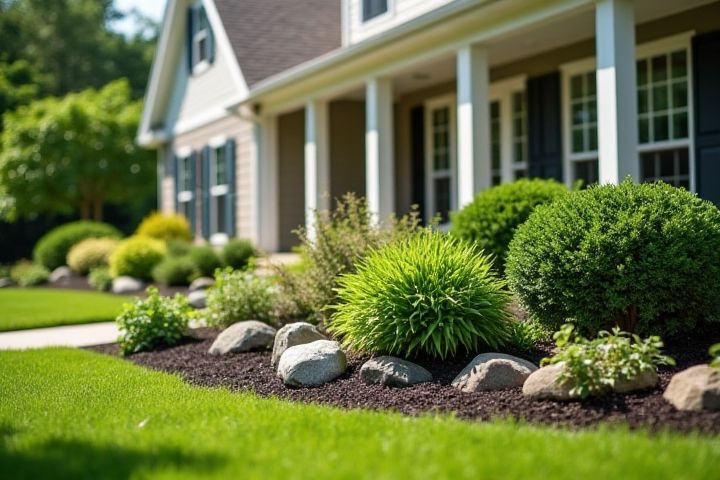
Start by evaluating the space and determining your desired landscape style, whether it's contemporary, cottage, or minimalist. Incorporate native plants that thrive in your climate, reducing maintenance and watering needs while enhancing local biodiversity. Lay out walkways with durable materials like brick, stone, or gravel to create inviting paths and define different areas of your front yard. Implement lighting features such as solar-powered path lights or accent lamps to highlight architectural elements and improve safety at night. Consider adding decorative elements like benches, bird baths, or sculptures to enhance the aesthetic appeal and provide functional spaces for relaxation.
How To Landscape House Front Yard
Analyze soil and climate suitability
To landscape your front yard effectively, start by analyzing your soil type, which can influence plant growth and health. Conduct a soil test to determine pH levels and nutrient content, enabling you to amend the soil as needed for optimal plant performance. Next, assess the local climate, including temperature ranges, precipitation patterns, and sun exposure, to select suitable plants that thrive in your region. By matching plant selections to your soil and climate conditions, you create a sustainable and visually appealing landscape.
Establish a focal point for design
Establishing a focal point in your front yard landscape enhances visual appeal and provides a clear design direction. You can choose various elements such as a unique tree, bold sculpture, or a beautifully arranged flower bed as your focal point. Surround this centerpiece with complementary plants and pathways that draw the eye toward it, creating harmony in your landscape. To enhance the effect, consider lighting options that highlight the focal point during evening hours, making it a captivating feature both day and night.
Incorporate native plants
Incorporating native plants into your front yard landscape design enhances biodiversity while requiring less maintenance and water. Choose plants that are well-adapted to your local climate and soil conditions, such as coneflowers, black-eyed Susans, and various grasses, which attract pollinators like bees and butterflies. Arrange these plants in clusters for a natural look, and consider creating layered plantings to add visual interest and depth. By prioritizing native species, you not only promote ecological health but also create a vibrant and inviting outdoor space for your home.
Plan for scale and proportion
To achieve a visually pleasing front yard, focus on the scale and proportion of your landscaping elements. Choose plants that suit your home's architecture; for instance, larger shrubs can complement a grand house, while smaller flowers may enhance a cozy cottage. When laying out pathways or patio areas, aim for a ratio of 1:3 for plant beds to hardscaping to maintain balance. Incorporate focal points, like a decorative bench or statue, that draw the eye yet harmonize with surrounding features, ensuring all elements coexist in visual harmony.
Consider seasonal changes
When landscaping your front yard, consider the four distinct seasons to create a vibrant and cohesive look year-round. In spring, opt for colorful perennials such as tulips and daffodils, which bloom early and set a cheerful tone. Summer should feature drought-resistant plants, like lavender or succulents, which thrive in warmer weather and require less maintenance, while fall can introduce ornamental grasses and deciduous trees that showcase stunning foliage. In winter, evergreens such as holly or pine can provide structure and greenery, ensuring your front yard remains visually appealing even in the colder months.
Ensure proper drainage
To effectively landscape your front yard while ensuring proper drainage, assess the natural slope of your property, which influences water runoff. Incorporate garden beds with native plants that thrive in your climate and can absorb excess moisture, reducing the risk of standing water. Utilize hardscape elements like permeable pavers or gravel pathways to promote water infiltration and direct runoff away from your house. Implementing a rain garden can also enhance aesthetic appeal while serving as a functional feature that captures and manages stormwater.
Use a variety of textures
Incorporating a variety of textures in your front yard landscaping elevates both visual appeal and sensory experience. Consider integrating smooth river stones, rough bark mulch, and lush, feathery grasses to create contrast and depth. You can also enhance the landscape by including flowering plants with varying leaf shapes and sizes, such as broad-leaved hostas alongside delicate ferns. This thoughtful combination not only draws the eye but also invites a tactile exploration of your outdoor space.
Optimize lighting and pathways
To enhance your front yard landscape, start by strategically positioning outdoor lighting fixtures to highlight the architectural features of your home and illuminate pathways. Use solar-powered LED lights, which can reduce energy consumption by up to 80%, to create a welcoming ambiance while ensuring safety during nighttime. Incorporate natural stone pavers or decorative concrete for pathways; both options can withstand various weather conditions and require minimal maintenance. Ensure that your pathways have a width of at least 36 inches to provide easy navigation, especially for guests and family members.
Incorporate sustainable practices
Incorporating sustainable practices in your front yard landscaping can significantly enhance your home's curb appeal while promoting environmental health. Begin by selecting native plants that require less water and are better adapted to your local climate, reducing your irrigation needs by up to 50%. Implementing drought-resistant landscaping techniques, such as xeriscaping, not only conserves water but also minimizes maintenance costs long-term. Finally, using organic mulch can improve soil health, reduce weeds, and retain moisture, ensuring your front yard remains vibrant and eco-friendly.
Allocate space for utility and aesthetics
When landscaping your front yard, allocate approximately 30% of the space for utility, such as pathways, seating areas, and storage solutions. Ensure that functional elements like walkways are both accessible and aesthetically pleasing, using materials like natural stone or decorative pavers to enhance visual appeal. Dedicate the remaining 70% to aesthetics by incorporating a variety of plants, seasonal flowers, and ornamental features like fountains or sculptures, creating a vibrant and welcoming atmosphere. To maintain harmony, select plants that complement your home's architecture and thrive in your local climate, ensuring beauty year-round.
